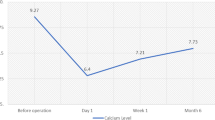Abstract
Introduction. In operations for renal hyperparathyroidism the value of intraoperative parathormone monitoring was investigated.
Patients and methods. Intraoperative intact parathyroid hormone levels were determined (PTH Quick assay) in 40 patients undergoing first cervical exploration and in two patients with graft-dependent recurrence of renal hyperparathyroidism.
Results. In 33 patients, total parathyroidectomy with autotransplantation was carried out. The median parathormone levels decreased from 652 pg/ml to 120 pg/ml (19% of initial level) 5 min after total parathyroidectomy. In seven patients, fewer than 4 parathyroid glands each were identified during cervical exploration and “total parathyroidectomy (?)” without autotransplantation was performed. Intraoperatively median parathormone level decreased from 1193 pg/ml to 116 pg/ml (10% of initial level). In one of these seven patients, hyperparathyroidism persisted due to an ectopic fourth gland within the carotid sheath. In two of these patients, hypoparathyroidism occurred and a delayed autotransplantation of cryopreserved parathyroid tissue was carried out. On the first day after total parathyroidectomy with autotransplantation and “total parathyroidectomy (?)”, median levels of intact parathyroid hormone were 1.9 pg/ml and 82.5 pg/ml, respectively.
Conclusion. Intraoperative monitoring is not useful in first cervical exploration for renal hyperparathyroidism because it cannot predict complete resection of parathyroid tissue. The parathormone level on the first postoperative day allows precise evaluation of the efficacy of the surgical procedure.
Zusammenfassung
Hintergrund. Die Wertigkeit des intraoperativen Parathormonmonitorings bei Eingriffen wegen eines renalen Hyperparathyreoidismus wurde evaluiert.
Patienten und Methodik. Bei 40 Patienten mit erstmaliger Halsexploration und bei 2 Patienten mit Transplantatrezidiv erfolgte ein intraoperatives Parathormonmonitoring (intaktes Parathormon, Quick-Assay).
Ergebnisse. Bei 33 Patienten erfolgten totale Parathyreoidektomien mit autologer Epithelkörperchenreplantation. Der präoperative mediane Parathormonspiegel von 652 pg/ml sank 5 min nach totaler Parathyreoidektomie auf 120 pg/ml (19% des Ausgangswertes). Bei 7 Patienten wurden im Rahmen der Halsexploration jeweils weniger als 4 Nebenschilddrüsen identifiziert und der Eingriff als 6 “totale Para-thyreoidektomie (?)” ohne Autotransplantation beendet. Der mediane Parathormonspiegel fiel von 1.193 pg/ml auf 116 pg/ml (10% des Ausgangswertes). Bei einem dieser 7 Patienten persistierte der Hyperparathyreoidismus aufgrund einer ektopen 4. Drüse in der Karotisscheide, und bei 2 Patienten erfolgte aufgrund eines Hypoparathyreoidismus die verzögerte Replantation kältekonservierten Nebenschilddrüsengewebes. Die am 1. Tag nach totaler Parathyreoidektomie mit Autotransplantation bzw. “totaler Parathyreoidektomie (?)” ermittelten Parathormonspiegel betrugen 1,9 pg/ml bzw. 82,5 pg/ml.
Schlussfolgerung. Das intraoperative Parathormonmonitoring lieferte bei der zervikalen Erstexploration wegen eines renalen Hyperparathyreoidismus keine über den makroskopischen Aspekt des Eingriffs hinausgehenden Informationen. Eine sichere Aussage bzgl. der Vollständigkeit der Exstirpation hyperaktiven Nebenschilddrüsengewebes gewährleistete erst der am 1. postoperativen Tag ermittelte Para-thormonspiegel.
Similar content being viewed by others
Author information
Authors and Affiliations
Rights and permissions
About this article
Cite this article
Walgenbach, S., Junginger, T. Intraoperatives Parathormonmonitoring bei der Halsexploration wegen renalem Hyperparathyreoidismus?. Chirurg 73, 211–216 (2002). https://doi.org/10.1007/s00104-001-0387-z
Published:
Issue Date:
DOI: https://doi.org/10.1007/s00104-001-0387-z




